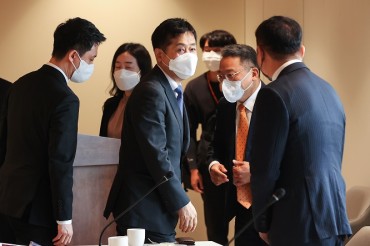
The Taegeukgi, Korea’s national flag, thought to have been used during the signing of a 1882 treaty between the Joseon Dynasty and the United States, is on display at the Library of Congress in Washington on May 22, 2024. (Image courtesy of Yonhap)
WASHINGTON, May 22 (Korea Bizwire) — From Korea’s ancient metal types to its first national flag and centuries-old books, the Library of Congress in Washington boasts a treasure trove of materials encapsulating the Asian country’s historical and cultural richness, and pride.
Part of its Korean collections were showcased Wednesday as South Korean Ambassador to the United States Cho Hyun-dong visited the library in part to mark the day when the Joseon Dynasty (1392-1910) signed a treaty with Washington in 1882 to open bilateral relations.
Among the items on display were an early version of the Taegeukgi, Korea’s national flag that was thought to have been used during the signing of the 1882 treaty, as well as a copy of “Dongguk Yi Sangguk jip,” a compilation book written in 1241 by Yi Kyu-bo, a scholar from the Goryeo Dynasty (918-1392).
Many of the items were part of the collections donated by Robert Wilson Shufeldt, who signed the bilateral treaty, and by James Gale, a Canadian Presbyterian missionary noted for his translation of the Bible and Christian literature into Korean.
Elli Sua Kim, the library’s Asia division reference librarian, walked the ambassador and other visitors through the Korean collections. She is one of the 10 librarians of Korean descent there.
“Can we assume that this Taegeukgi — used on May 22, 1882, when the treaty was signed — was the first (Korean national flag)?” Cho asked Kim, according to a pool report.
“Though this is very small in fact, it carries real significance in that Korea’s Taegeukgi was used for the first time in its diplomatic history,” Kim said.
Ambassador Cho called the treaty the starting point of the Korea-U.S. partnership, though the two countries’ alliance was born under a mutual defense treaty signed after the 1950-53 Korean War.
Kim drew particular attention to the copy of “Dongguk Yi Sangguk jip” that mentions the founding myth of Goguryeo — an ancient Korean kingdom that some Chinese historians are said to claim as part of Chinese history in a state-sponsored research project, called the Northeast Project.

Ancient Korean metal types are on display at the Library of Congress in Washington on May 22, 2024. (Image courtesy of Yonhap)
“This book is very important as China has been conducting the Northeast Project,” Kim said. “The claim is that Goguryeo was part of China. This is so important a book to refute that.”
Kim also stressed that the book talks about how to make kimchi, a Korean traditional side dish made of fermented vegetables that some Chinese see as having originated in China.
“Some call kimchi a dish from China. But in ‘Dongguk Yi Sangguk jip,’ Yi Kyu-bo already talked about six vegetables (used to make kimchi), the history of kimchi and how to make it,” she said.
The librarian also explained Korea’s advanced skills in making metal and wooden types in ancient times.
“Especially metal types. … These are real treasures that require two security personnel to bring them out (for a showcase),” she said.
During a meeting with librarians, Youngsim Leigh, in charge of the Northeast Asian section, said that there is a Korean head sculpture among the 33 sculptures of different races on display at the library.
Cho expressed his appreciation to the librarians for the preservation of the Korean collections.
“Many citizens are not aware that the Library of Congress has such really good, precious heritage pieces,” he said. “These will form a foundation to further solidify the Korea-U.S. relationship in the long term.”
Leigh expressed hopes that the National Library of Korea and the National Assembly Library — the counterparts of the U.S. library — would provide more materials to the U.S. to help enrich the Korean collections in Washington.
(Yonhap)






